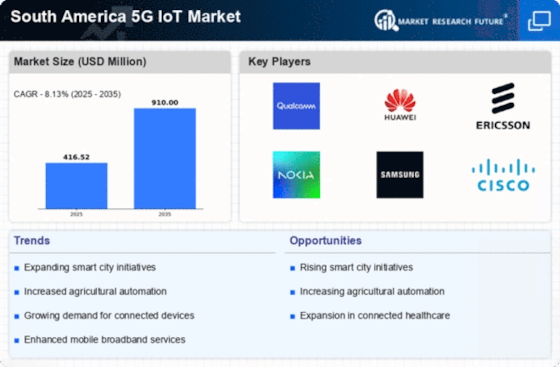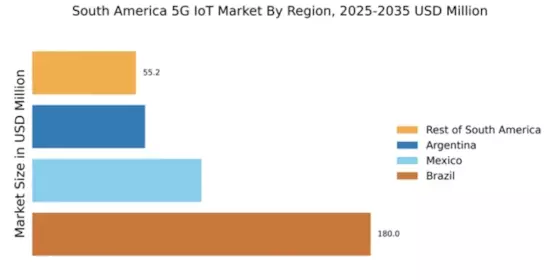Rise of Industrial Automation
The rise of industrial automation in South America is driving the 5g iot market forward. Industries such as manufacturing, logistics, and energy are increasingly adopting IoT solutions to enhance operational efficiency and reduce costs. The integration of 5G technology allows for real-time data transmission and remote monitoring, which are essential for automated processes. For example, the manufacturing sector is projected to see a 20% increase in productivity due to the implementation of smart factories powered by 5G. This trend is likely to attract significant investments, with estimates suggesting that the industrial IoT market could reach $5 billion in South America by 2025. As companies seek to optimize their operations, the demand for 5G-enabled IoT solutions will continue to grow.
Increased Focus on Sustainability
The increased focus on sustainability is shaping the 5g iot market in South America. As environmental concerns rise, businesses and governments are seeking solutions that minimize their ecological footprint. 5G technology enables the deployment of smart grids, waste management systems, and energy-efficient buildings, which contribute to sustainable development. For example, smart energy management systems can reduce energy consumption by up to 25%, aligning with global sustainability goals. Additionally, the South American region is witnessing a surge in investments aimed at green technologies, with projections indicating that the market for sustainable IoT solutions could reach $4 billion by 2025. This emphasis on sustainability is likely to drive the adoption of 5G-enabled IoT applications.
Government Initiatives and Support
Government initiatives aimed at promoting digital transformation are significantly influencing the 5g iot market in South America. Various countries in the region are implementing policies to foster innovation and technological advancement. For instance, Brazil's National Broadband Plan aims to expand internet access to underserved areas, which is likely to enhance the adoption of 5G technologies. Additionally, public-private partnerships are emerging to facilitate investments in telecommunications infrastructure. The South American governments are also providing financial incentives for companies to develop IoT solutions that leverage 5G capabilities. This supportive regulatory environment is expected to stimulate growth in the 5g iot market, with an estimated increase in investment reaching $10 billion by 2026.
Growing Demand for Enhanced Connectivity
The increasing demand for enhanced connectivity in South America is a primary driver for the 5g iot market. As urbanization accelerates, the need for reliable and high-speed internet access becomes paramount. This demand is reflected in the projected growth of mobile data traffic, which is expected to reach 30 exabytes per month by 2025 in the region. Businesses and consumers alike are seeking faster and more efficient communication solutions, which 5G technology can provide. The ability to connect multiple devices seamlessly is crucial for various sectors, including healthcare, transportation, and manufacturing. Consequently, telecommunications companies are investing heavily in infrastructure to support this demand, thereby propelling the growth of the 5g iot market.
Emergence of Smart Transportation Solutions
The emergence of smart transportation solutions is a crucial driver for the 5g iot market in South America. As urban areas grapple with traffic congestion and pollution, there is a pressing need for innovative transportation systems. 5G technology facilitates the development of connected vehicles and intelligent traffic management systems, which can significantly improve mobility and safety. For instance, the implementation of smart traffic lights and real-time monitoring can reduce travel times by up to 30%. Furthermore, the South American governments are investing in infrastructure to support these initiatives, with an estimated $3 billion allocated for smart transportation projects by 2027. This focus on enhancing transportation networks is likely to bolster the growth of the 5g iot market.


















Leave a Comment